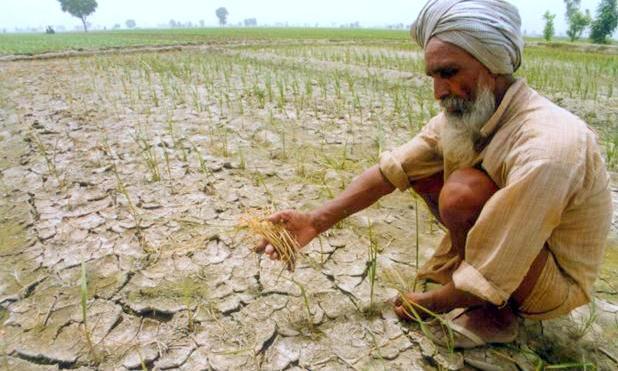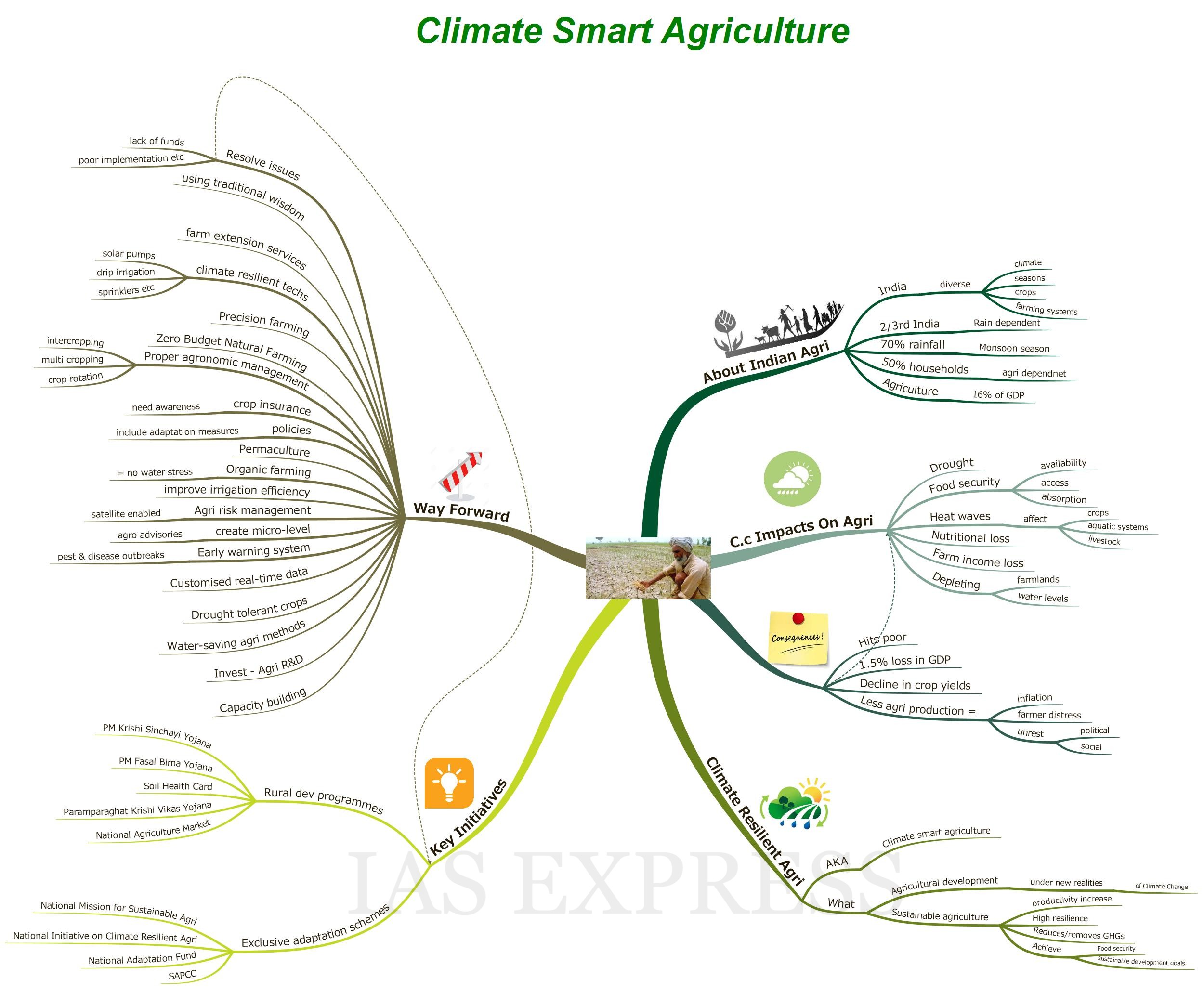Climate Smart Agriculture in India – Benefits and Key Initiatives

From Current Affairs Notes for UPSC » Editorials & In-depths » This topic
IAS EXPRESS Vs UPSC Prelims 2024: 85+ questions reflected
India’s agricultural sector has seen a considerable threat from climate change and it directly impacts the daily lives of farmers. A study found that climate change could have contributed to the deaths of more than 50,000 farmers or farm workers over the last 30 years. Thus the efforts to make agriculture resilient to climate must be increased and sustained in order to avoid the impacts of a warming world.
About Indian agriculture
- India is a large country with diverse climate, seasons, crops and farming systems.
- 2/3rd of India is rain dependent and India gets around 70% of its annual rainfall during the monsoon season.
- Around 50% of households in India are dependent on agriculture for their livelihood.
- Agriculture contributes 16% of India’s GDP.
How climate change affects Indian agriculture?
- Drought: India is highly dependent on monsoon and with 85% of small and marginal landholdings, it is highly sensitive to climate change and its effects. There has been less than normal rainfall during the last 4 years, with 2014 and 2015 declared as drought years.
- Food security: Climate change impacts all the 3 aspects of food security viz – availability, access, and absorption.
- Heat waves: caused by global warming affect crops, aquatic systems, and livestock.
- The World bank report warned that by 2040s, India would see a considerable reduction in crop yields due to extreme heat.
- Heat waves threaten livestock by increasing their vulnerability to disease, reducing fertility, and milk production.
- Heat stress also considerably affect the commercial poultry.
- Nutritional loss: Rising levels of atmospheric CO2 minimize the concentrations of protein and essential minerals in most plant species, including wheat, soybeans, and rice etc.
- Farm income loss: The Economic survey of 2017-18 points out the estimated farm income losses between 15% and 18% on average, which could rise to 20-25% for unirrigated areas without policy interventions. A study found that climate change could have contributed to the deaths of more than 50,000 farmers or farm workers over the last 30 years.
- Depleting farmlands and water levels: rising sea level may result in loss of farmland by inundation and increasing salinity of groundwater in coastal areas. Changes in precipitation levels and falling groundwater tables depletes water availability.
What are the consequences?
- Climate change hits the poor the most.
- Since agriculture contributes 16% of India’s GDP, climate change causes about 1.5% loss in GDP.
- By 2030, rice and wheat are likely to see around 6-10% decline in yields.
- Poor agricultural production may lead to inflation, farmer distress and larger political and social unrest.
- According to 2018 Economic Survey, India incurs about $9-10 billion losses annually because of extreme weather events. It also noted that farmers’ income losses from climate change would be between 15% and 18% on an average.
- All of the above can hold back the economy.
What is climate resilient agriculture?
- Climate-resilient agriculture or Climate-smart agriculture (CSA) may be defined as an approach for transforming and reorienting agricultural development under the new realities of climate change.
- The most commonly used definition is provided by the Food and Agricultural Organisation of the United Nations (FAO), which defines CSA as “agriculture that sustainably increases productivity, enhances resilience (adaptation), reduces/removes GHGs (mitigation) where possible, and enhances achievement of national food security and development goals”.
- In this definition, the principal goal of CSA is identified as food security and development, while productivity, adaptation, and mitigation are identified as the three interlinked pillars necessary for achieving this goal.
What are the key initiatives taken towards climate resilient agriculture?
Initiatives like PM Krishi Sinchayee Yojana (Agri productivity), PM Fasal Bima Yojana (Agri Insurance), Soil Health Card, Paramparagat Krishi Vikas Yojana (Organic farming), National Agriculture Market (e-NAM) and other rural development programmes are positive interventions.
Exclusive climate and adaptation schemes in agriculture are as follows
National Mission for sustainable Agriculture
- It is one of the 9 missions under the National Action Plan for Climate Change (NAPCC).
- The aim is to make Indian Agriculture more resilient to climate change through suitable adaptation n mitigation measures in the domain of crops n animal husbandry
- Mission Plan
- Make Plants tolerant to Heat, Moisture and High salinity
- Improve Pest management and Water management by modifying crop management practices
- Use resource conserving technologies
- Crop diversification
- Crop insurance
- Timely weather based advisories
- Harnessing farmer’s traditional technical knowledge
- The system of Rice Intensification (SRI) which uses less water
National Initiative on Climate Resilient Agriculture (NICRA)
- A Network Project to enhance the resilience of Indian Agriculture to climate change and climate vulnerability through strategic research, technology demonstration, capacity building etc
- By Indian Council of Agricultural Research (ICAR)
National Adaptation Fund
- The objective of the fund is to assist State and Union Territories that are particularly vulnerable to the adverse effects of climate change in meeting the cost of adaptation
- The National Bank for Agriculture and Rural Development (NABARD) has been appointed as National Implementing Entity (NIE) responsible for implementation of adaptation projects under the (NAFCC).
- The focus of the fund is to assist adaptation projects and programmes to support concrete adaptation activities that reduce the effects of climate change facing communities and sectors.
- The Adaptation Fund is to assist States that are particularly vulnerable, based on the needs and priorities identified under the SAPCC and the relevant Missions under NAPCC.
State Action Plans on Climate Change (SAPCC)
- SAPCC is an important platform for adaptation planning.
- Under it, states are encouraged by the centre to adopt innovative measures to develop resilience against climate change and include it in their planning process.
- Some of the components under these schemes are integrated with major rural development programmes of the centre, which will further increase their effectiveness at the grass-root level.
What are the steps needed?
- The initiatives have been marred by lack of funds, poor implementation etc. which needs to be solved.
- In addition to traditional wisdom, farm extension services and climate resilient techs should guide farmers’ responses to climate change.
- The climate resilient techniques include the solar pump, drip irrigation, and sprinklers which involves minimum consumption of electricity and water could be utilized.
- Precision farming techniques could be adopted for improving productivity, quality, and profitability in Indian agriculture.
- Adoption of Zero Budget Natural Farming.
- Climate change mitigation in agriculture should also involve proper agronomic management practices like intercropping, multi-cropping and crop-rotation at the field level.
- A recent study reveals that a very small portion of agriculture households utilized crop insurance because of lack of adequate awareness and knowledge. Hence, there is an urgent need to educate farmers by providing Krishi Vigyan Kendras with more funds for climate change and risk mitigating measures. Also, weather-based model and technology could be used to determine losses and compensate farmers within weeks (Kenya does it in a few days).
- Climate adaptations should be included in the policy framework to enable identification of many challenges that prevent up-scaling efforts and adaptation by farmers.
- Increasing area under permaculture (a self-sustaining agricultural system).
- Applying farmyard manure, compost or by practicing organic farming could improve the soil organic matter which can help in the improvement of soil health.
- Other initiatives for creating greater resilience in agriculture should include
- improving irrigation efficiency,
- encouraging satellite enabled agriculture risk management,
- creating micro-level agro advisories,
- providing customised real-time data,
- Early warning system to monitor changes in pest and disease outbreaks
- Promoting drought-tolerant crops and water saving agro-methods such as System of Rice Intensification (SRI),
- Investment in R&D to spur innovations in sustainable climate-friendly agricultural productivity and the private sector can help in this,
- Capacity building of stakeholders.
If you like this post, please share your feedback in the comments section below so that we will upload more posts like this.


